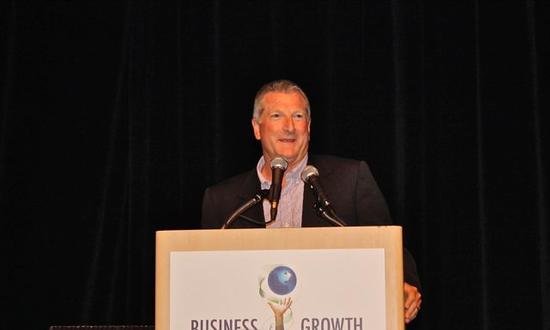Editor’s note: I went to the Business Growth Conference 2010 in Anaheim yesterday to hear Quiksilver CEO Bob McKnight’s keynote address. I wrote the story below for the Orange County Register. It’s in a more formal, newspaper style than you usually find here.
ANAHEIM – Quiksilver Inc. Chief Executive Robert McKnight, Jr. recounted the growth story of Quiksilver from its humble roots making boardshorts for surfers to its current status as the world’s largest action sports company during his keynote speech Thursday at the Business Growth Conference 2010.
McKnight also detailed how Huntington Beach-based Quiksilver has navigated the current economic downtown and attempted to recover from its failed 2005 acquisition of the French ski brand, Rossignol.
In 1976, McKnight, a recent USC graduate armed with a business degree, began working with pro surfer Jeff Hakman to bring Quiksilver boardshorts to the U.S. from the brand’s native Australia. McKnight thought he was embarking on a one-year project.
He put the snaps on every pair of boardshorts in the beginning and sold the shorts to surf shops from the trunk of his car.
 Flash forward 34 years. Quiksilver has $2 billion in annual revenue, 7,000 employees around the world, makes 100 million garments a year, and has three core brands: Quiksilver, Roxy and DC.
Flash forward 34 years. Quiksilver has $2 billion in annual revenue, 7,000 employees around the world, makes 100 million garments a year, and has three core brands: Quiksilver, Roxy and DC.
One thing is the same, McKnight said. He is still running the company, “my one and only job.”
(Right: McKnight gets mobbed after his speech.)
McKnight did not gloss over the recent struggles of the company. He said Quiksilver’s $1 billion in debt was the result of its “dubious acquisition” of Rossignol, which the company sold in 2008.
The debt, combined with the drop in consumer spending and tight credit markets, led to one of “the most financially and emotionally painful chapters in Quiksilver’s history,” he said.
During this time, the company’s stock dropped from $15 to a low of 88 cents in November 2008. “Very dark days,” McKnight said.
To survive, Quiksilver refinanced its capital structure and received a strategic investment from international private equity firm Rhone.
It lined up new credit agreements, which gave the company liquidity it needed to operate.
And it embarked on a major cost-reduction initiative, cutting $150 million in expenses and reducing staff by 25% – a difficult task for a company used to recording double digit revenue growth for 15 years.
McKnight told the approximately 700 people in the audience that the company learned valuables lessons through those dark days. To keep inventory levels in line with market conditions. To closely watch capital expenditures, receivables and the number of styles in its lines.
And, the importance of cash. “Cash was the lifeblood to any business during this period,” he said.
The recession has also focused the company even more on making great product that its fickle 16-year-old customer will get excited about.
“Good product is mission No. 1,” McKnight said.
Quiksilver is now concentrating on what it calls its core distribution channel – the surf, skate and snowboard shops that has made it what it is.
While tough, Quiksilver’s recent troubles have made the company “much leaner, much tougher and much more nimble,” McKnight said.
Now that Quiksilver’s financial crisis has stabilized, he’s thrilled to be spending his time working on products and marketing campaigns and hanging out with team riders instead of “hanging out with bankers or in the office of the CFO – no offense, Joe,” he said to Quiksilver CFO Joe Scirocco, who was in the audience.






